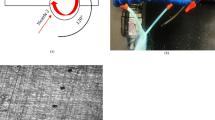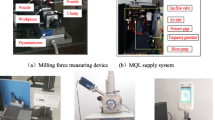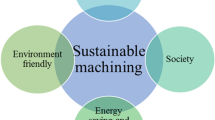Abstract
The precision of lightweight components produced during machining of aluminium alloy is critical as a reason of its high chemical reactivity to the tool metal when cutting. Mineral-based cutting fluids (CFs) used in the manufacturing industry pollute the environment and offer adequate health risks to the operators; it is vital to develop environmentally friendly machining technologies. As a corollary, vegetable oil (VO) must be used to replace mineral oil to avoid pollution. In recent decades, VO produced from raw edible sources is a reliable source for greener CF. Toxic fumes and skin irritations caused by conventional CFs are all avoided when using VO in machining. In this research, an additively manufactured AlSi10Mg specimen was machined with distinct coolants to enhance the surface trait. The mechanical performance such as tensile, hardness and wear strength were investigated to prove that the 90° oriented AlSi10Mg parts show better strength. Further, the machining of 90° oriented AlSi10Mg parts was performed to examine certain issues such as surface morphology, flank wear and cutting temperature using different cooling regimes (flood and MQL with soybean oil). As a result of heat generation in the cutting zone, the surface deteriorates and the cutter needs to be replaced often. The MQL with VO minimises the heat generated at the cutting region and lessened the roughness to 25–42% and temperature to 24–39% with flood coolant. Additionally, the microstructure under MQL cutting produced fine grains. The desirability function was employed to find the ideal cutting condition for sustainable manufacturing.



















Similar content being viewed by others
References
Maamoun AH, Elbestawi MA, Veldhuis SC (2018) Influence of shot peening on alsi10mg parts fabricated by additive manufacturing. J Manuf Mater Process 2:1–16. https://doi.org/10.3390/jmmp2030040
Kayacan MY, Özsoy K, Duman B et al (2019) A study on elimination of failures resulting from layering and internal stresses in powder bed fusion (PBF) additive manufacturing. Mater Manuf Process 34:1467–1475. https://doi.org/10.1080/10426914.2019.1655151
Della Gatta R, Del Sol I, Caraviello A, Astarita A (2021) Selective laser melting of an Al-Si-Mg-Cu alloy: feasibility and processing aspects. Mater Manuf Process 36:1438–1449. https://doi.org/10.1080/10426914.2021.1906900
Saravanakumar A, Rajeshkumar L, Balaji D, Jithin Karunan MP (2020) Prediction of wear characteristics of AA2219-Gr matrix composites using GRNN and Taguchi-based approach. Arab J Sci Eng 45:9549–9557. https://doi.org/10.1007/s13369-020-04817-8
Lee H, Lim CHJ, Low MJ et al (2017) Lasers in additive manufacturing: a review. Int J Precis Eng Manuf - Green Technol 4:307–322. https://doi.org/10.1007/s40684-017-0037-7
Kumar MS, Javidrad HR, Shanmugam R et al (2021) Impact of print orientation on morphological and mechanical properties of L-PBF based AlSi7Mg parts for aerospace applications. SILICON. https://doi.org/10.1007/s12633-021-01474-w
Shakerin S, Hadadzadeh A, Amirkhiz BS et al (2019) Additive manufacturing of maraging steel-H13 bimetals using laser powder bed fusion technique. Addit Manuf 29:100797. https://doi.org/10.1016/j.addma.2019.100797
Koutiri I, Pessard E, Peyre P et al (2018) Influence of SLM process parameters on the surface finish, porosity rate and fatigue behavior of as-built Inconel 625 parts. J Mater Process Technol 255:536–546. https://doi.org/10.1016/j.jmatprotec.2017.12.043
Yap CY, Chua CK, Dong ZL et al (2015) Review of selective laser melting: materials and applications. Appl Phys Rev 2. https://doi.org/10.1063/1.4935926
Zakay A, Aghion E (2019) Effect of post-heat treatment on the corrosion behavior of AlSi10Mg alloy produced by additive manufacturing. Jom 71:1150–1157. https://doi.org/10.1007/s11837-018-3298-x
Li X, Ni J, Zhu Q et al (2017) Structure and mechanical properties of the AlSi10Mg alloy samples manufactured by selective laser melting. IOP Conf Ser Mater Sci Eng 269. https://doi.org/10.1088/1757-899X/269/1/012081
Rajesh Kumar L, Saravanakumar A, Bhuvaneswari V et al (2019) Optimization of wear behaviour for AA2219-MoS2 metal matrix composites in dry and lubricated condition. Mater Today Proc 27:2645–2649. https://doi.org/10.1016/j.matpr.2019.11.087
Baitimerov R, Lykov P, Zherebtsov D et al (2018) Influence of powder characteristics on processability of AlSi12 alloy fabricated by selective laser melting. Materials (Basel) 11:1–14. https://doi.org/10.3390/ma11050742
Nicoletto G (2020) Influence of rough as-built surfaces on smooth and notched fatigue behavior of L-PBF AlSi10Mg. Addit Manuf 34:101251. https://doi.org/10.1016/j.addma.2020.101251
Saravanakumar A, Sivalingam S, Kumar LR (2018) Dry sliding wear of AA2219/Gr metal matrix composites. Mater Today Proc 5:8321–8327. https://doi.org/10.1016/j.matpr.2017.11.524
Salmi A, Atzeni E (2020) Residual stress analysis of thin AlSi10Mg parts produced by laser powder bed fusion. Virtual Phys Prototyp 15:49–61. https://doi.org/10.1080/17452759.2019.1650237
Letenneur M, Kreitcberg A, Brailovski V (2019) Optimization of laser powder bed fusion processing using a combination of melt pool modeling and design of experiment approaches: density control. J Manuf Mater Process 3. https://doi.org/10.3390/jmmp3010021
Tofail SAM, Koumoulos EP, Bandyopadhyay A et al (2018) Additive manufacturing: scientific and technological challenges, market uptake and opportunities. Mater Today 21:22–37. https://doi.org/10.1016/j.mattod.2017.07.001
Shanmugam R, Ramoni M, Thangamani G, Thangaraj M (2021) Influence of additive manufactured stainless steel tool electrode on machinability of beta titanium alloy. Metals (Basel) 11. https://doi.org/10.3390/met11050778
Nguyen QB, Luu DN, Nai SML et al (2018) The role of powder layer thickness on the quality of SLM printed parts. Arch Civ Mech Eng 18:948–955. https://doi.org/10.1016/j.acme.2018.01.015
Nimel Sworna Ross K, Manimaran G (2019) Effect of cryogenic coolant on machinability of difficult-to-machine Ni–Cr alloy using PVD-TiAlN coated WC tool. J Brazilian Soc Mech Sci Eng 41:1–14. https://doi.org/10.1007/s40430-018-1552-3
Zhang H, Dang J, Ming W et al (2020) Cutting responses of additive manufactured Ti6Al4V with solid ceramic tool under dry high-speed milling processes. Ceram Int 46:14536–14547. https://doi.org/10.1016/j.ceramint.2020.02.253
Zimmermann M, Müller D, Kirsch B et al (2021) Analysis of the machinability when milling AlSi10Mg additively manufactured via laser-based powder bed fusion. Int J Adv Manuf Technol 112:989–1005. https://doi.org/10.1007/s00170-020-06391-7
Dabwan A, Anwar S, Al-Samhan AM et al (2021) Investigations on the effect of layers’ thickness and orientations in the machining of additively manufactured stainless steel 316l. Materials (Basel) 14. https://doi.org/10.3390/ma14071797
Khan HM, Karabulut Y, Kitay O et al (2020) Influence of the post-processing operations on surface integrity of metal components produced by laser powder bed fusion additive manufacturing: a review. Mach Sci Technol 25:118–176. https://doi.org/10.1080/10910344.2020.1855649
Nimel Sworna Ross K, Manimaran G, Anwar S et al (2021) Investigation of surface modification and tool wear on milling Nimonic 80A under hybrid lubrication. Tribol Int 155:106762. https://doi.org/10.1016/j.triboint.2020.106762
Ross NS, Mia M, Anwar S et al (2021) A hybrid approach of cooling lubrication for sustainable and optimized machining of Ni-based industrial alloy. J Clean Prod 321:128987. https://doi.org/10.1016/j.jclepro.2021.128987
Ross NS, Sheeba PT, Jebaraj M, Stephen H (2021) Milling performance assessment of Ti-6Al-4V under CO2 cooling utilizing coated AlCrN/TiAlN insert. Mater Manuf Process 00:1–15. https://doi.org/10.1080/10426914.2021.2001510
Kannan C, Ramanujam R, Balan ASS (2018) Machinability studies on Al 7075/BN/Al2O3 squeeze cast hybrid nanocomposite under different machining environments. Mater Manuf Process 33:587–595. https://doi.org/10.1080/10426914.2017.1401718
Nimel Sworna Ross K, Manimaran G (2020) Machining investigation of Nimonic - 80A superalloy under cryogenic CO 2 as coolant using PVD - TiAlN / TiN coated tool at 45 ° nozzle angle. Arab J Sci Eng. https://doi.org/10.1007/s13369-020-04728-8
Struzikiewicz G, Sioma A (2020) Evaluation of surface roughness and defect formation after the machining of sintered aluminum alloy AlSi10Mg. Materials (Basel) 13. https://doi.org/10.3390/ma13071662
Saravana Kumar M, Mohan E, Robinson S, Thivya Prasad D (2021) Comparative study on morphological, physical and mechanical characteristics of L-PBF based AlSi10Mg parts with conventional stir casted Al-10 %SiC composites. SILICON. https://doi.org/10.1007/s12633-021-01065-9
Sk M, Rb S, M V, K NSR, (2020) Applying visualization techniques to study the fluid flow pattern and the particle distribution in the casting of metal matrix composites. J Manuf Process 58:668–676. https://doi.org/10.1016/j.jmapro.2020.08.044
Figiel H, Zogał O, Yartys V (2005) Journal of Alloys and Compounds: Preface. J Alloys Compd 404–406:1. https://doi.org/10.1016/j.jallcom.2005.05.002
Shaikh AS, Schulz F, Minet-Lallemand K, Hryha E (2021) Microstructure and mechanical properties of Haynes 282 superalloy produced by laser powder bed fusion. Mater Today Commun 26:102038. https://doi.org/10.1016/j.mtcomm.2021.102038
Kumar MS, Vasumathi M, Begum SR et al (2021) Influence of B4C and industrial waste fly ash reinforcement particles on the micro structural characteristics and mechanical behavior of aluminium (Al–Mg–Si-T6) hybrid metal matrix composite. J Mater Res Technol 15:1201–1216. https://doi.org/10.1016/j.jmrt.2021.08.149
Saravana Kumar M, Begum SR, Vasumathi M (2019) Influence of stir casting parameters on particle distribution in metal matrix composites using stir casting process. Mater Res Express 6:1065d4. https://doi.org/10.1088/2053-1591/ab4045
Saravana Kumar M, Pruncu CI, Harikrishnan P et al (2021) Experimental investigation of in-homogeneity in particle distribution during the processing of metal matrix composites. SILICON. https://doi.org/10.1007/s12633-020-00886-4
Günan F, Kıvak T, Yıldırım ÇV, Sarıkaya M (2020) Performance evaluation of MQL with AL 2 O 3 mixed nanofluids prepared at different concentrations in milling of Hastelloy C276 alloy. J Mater Res Technol 9:10386–10400. https://doi.org/10.1016/j.jmrt.2020.07.018
Yildirim ÇV, Kivak T, Sarikaya M, Şirin Ş (2020) Evaluation of tool wear, surface roughness/topography and chip morphology when machining of Ni-based alloy 625 under MQL, cryogenic cooling and CryoMQL. J Mater Res Technol 9:2079–2092. https://doi.org/10.1016/j.jmrt.2019.12.069
Sreejith PS (2008) Machining of 6061 aluminium alloy with MQL, dry and flooded lubricant conditions. Mater Lett 62:276–278. https://doi.org/10.1016/j.matlet.2007.05.019
Khan MMA, Mithu MAH, Dhar NR (2009) Effects of minimum quantity lubrication on turning AISI 9310 alloy steel using vegetable oil-based cutting fluid. J Mater Process Technol 209:5573–5583. https://doi.org/10.1016/j.jmatprotec.2009.05.014
Dhar NR, Kamruzzaman M, Ahmed M (2006) Effect of minimum quantity lubrication (MQL) on tool wear and surface roughness in turning AISI-4340 steel. J Mater Process Technol 172:299–304. https://doi.org/10.1016/j.jmatprotec.2005.09.022
Rakesh M, Datta S (2020) Machining of Inconel 718 using coated WC Tool: effects of cutting speed on chip morphology and mechanisms of tool wear. Arab J Sci Eng 45:797–816. https://doi.org/10.1007/s13369-019-04171-4
Gupta MK, Mia M, Jamil M et al (2020) Machinability investigations of hardened steel with biodegradable oil-based MQL spray system. Int J Adv Manuf Technol 108:735–748. https://doi.org/10.1007/s00170-020-05477-6
Królczyk G, Feldshtein E, Dyachkova L et al (2020) On the microstructure, strength, fracture, and tribological properties of iron-based MMCs with addition of mixed carbide nanoparticulates. Materials (Basel) 13. https://doi.org/10.3390/ma13132892
Ali SM, Dhar NR, Dey SK (2011) Effect of minimum quantity lubrication (Mql) on cutting performance in turning medium carbon steel by uncoated carbide insert at different speed-feed combinations. Adv Prod Eng Manag 6:185–196
Author information
Authors and Affiliations
Corresponding author
Ethics declarations
Ethics approval and consent to participate
Not applicable.
Additional information
Publisher’s note
Springer Nature remains neutral with regard to jurisdictional claims in published maps and institutional affiliations.
Rights and permissions
About this article
Cite this article
Ross, N.S., Ananth, M.B.J., Jafferson, J.M. et al. Performance assessment of vegetable oil–based MQL in milling of additively manufactured AlSi10Mg for sustainable production. Biomass Conv. Bioref. 14, 8693–8710 (2024). https://doi.org/10.1007/s13399-022-02967-3
Received:
Revised:
Accepted:
Published:
Issue Date:
DOI: https://doi.org/10.1007/s13399-022-02967-3




